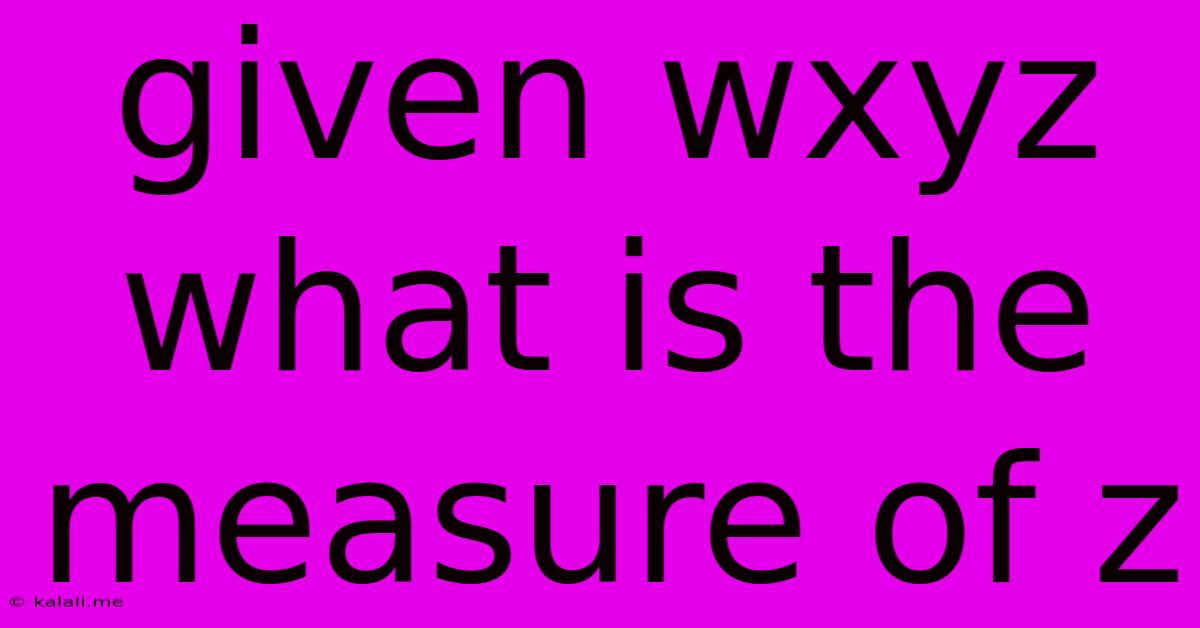Given Wxyz What Is The Measure Of Z
Kalali
Jun 14, 2025 · 3 min read

Table of Contents
Determining the Measure of Angle Z in Quadrilateral WXYZ
This article will guide you through the process of finding the measure of angle Z in quadrilateral WXYZ, given various scenarios. Understanding the properties of quadrilaterals, particularly the sum of interior angles, is crucial for solving this geometry problem. We will explore different approaches depending on the information provided. Knowing the types of quadrilaterals (squares, rectangles, parallelograms, trapezoids, etc.) will also significantly impact our method.
What Information Do We Need?
To calculate the measure of angle Z, we need additional information about quadrilateral WXYZ. This could include:
- The measures of angles W, X, and Y: Knowing three angles allows us to calculate the fourth, using the fact that the sum of interior angles in any quadrilateral is 360 degrees.
- The type of quadrilateral: If WXYZ is a specific type of quadrilateral (e.g., rectangle, parallelogram, rhombus, square, kite, trapezoid), we can use its unique properties to determine angle Z. For example, in a parallelogram, opposite angles are equal. In a rectangle, all angles are 90 degrees.
- Side lengths and relationships: Knowing the side lengths and whether sides are parallel or equal can help determine the type of quadrilateral and hence, the angles.
- Diagonals and their properties: Information about diagonals and their relationships can also be useful in specific cases.
Calculating Angle Z using the Sum of Interior Angles
This is the most fundamental approach. The sum of interior angles of any quadrilateral is always 360 degrees. Therefore, if we know the measures of angles W, X, and Y, we can find Z using the following equation:
∠W + ∠X + ∠Y + ∠Z = 360°
∠Z = 360° - (∠W + ∠X + ∠Y)
Example: If ∠W = 80°, ∠X = 100°, and ∠Y = 90°, then:
∠Z = 360° - (80° + 100° + 90°) = 360° - 270° = 90°
Calculating Angle Z using Properties of Specific Quadrilaterals
If we know the type of quadrilateral, we can utilize its specific properties. Here are some examples:
- Rectangle/Square: All angles are 90°. Therefore, ∠Z = 90°.
- Parallelogram: Opposite angles are equal. If we know ∠W, then ∠Y = ∠W, and if we know ∠X, then ∠Z = ∠X.
- Rhombus: Similar to a parallelogram, opposite angles are equal. Additionally, adjacent angles are supplementary (add up to 180°).
- Trapezoid: The sum of adjacent angles on the non-parallel sides is 180°. This property, combined with the sum of interior angles, can help find ∠Z.
- Kite: One pair of opposite angles are equal. This equality, combined with the total sum of 360°, allows for calculation.
Solving for Angle Z with Insufficient Information
Without sufficient information (angles W, X, Y, or the type of quadrilateral), determining the precise measure of angle Z is impossible. The problem requires at least three of the angles or sufficient information to define the quadrilateral's type.
Conclusion
Determining the measure of angle Z in quadrilateral WXYZ requires a systematic approach. This involves understanding the fundamental properties of quadrilaterals, particularly the sum of interior angles (360°). Leveraging information about other angles, the type of quadrilateral, or side lengths significantly simplifies the solution. Remember, without enough data, finding the exact measure of angle Z is not feasible. Always double-check your calculations to ensure accuracy.
Latest Posts
Latest Posts
-
What Is The Lcm Of 5 6 And 7
Jun 14, 2025
-
Part Of The Brain That Controls Heartbeat
Jun 14, 2025
-
Which Of The Following Is A Terrestrial Planet
Jun 14, 2025
-
The Temperature At Which A Solid Becomes A Liquid
Jun 14, 2025
-
Is 103 A Prime Or Composite Number
Jun 14, 2025
Related Post
Thank you for visiting our website which covers about Given Wxyz What Is The Measure Of Z . We hope the information provided has been useful to you. Feel free to contact us if you have any questions or need further assistance. See you next time and don't miss to bookmark.